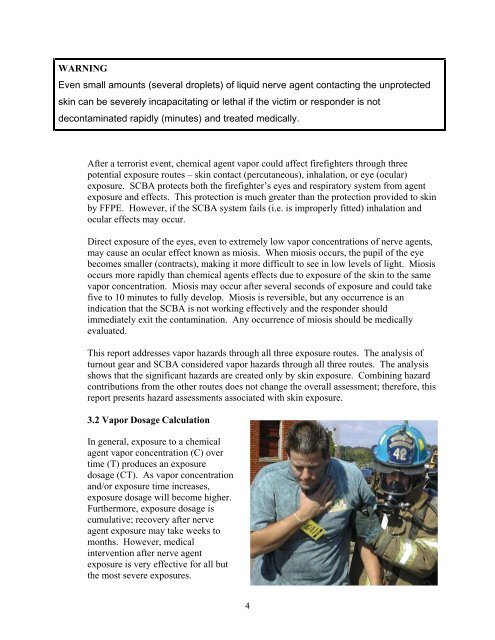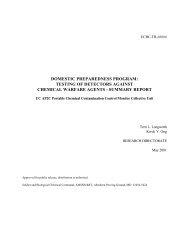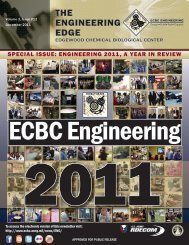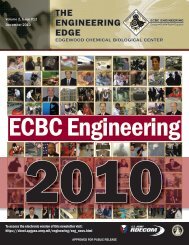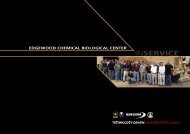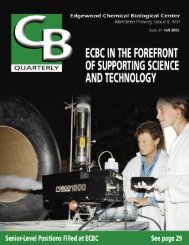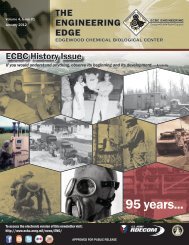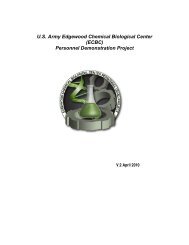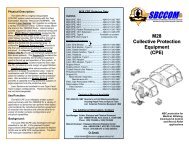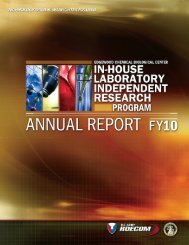(FFPE) with Self-Contained Breathing Apparatus (SCBA) for Rescue
(FFPE) with Self-Contained Breathing Apparatus (SCBA) for Rescue
(FFPE) with Self-Contained Breathing Apparatus (SCBA) for Rescue
You also want an ePaper? Increase the reach of your titles
YUMPU automatically turns print PDFs into web optimized ePapers that Google loves.
WARNING<br />
Even small amounts (several droplets) of liquid nerve agent contacting the unprotected<br />
skin can be severely incapacitating or lethal if the victim or responder is not<br />
decontaminated rapidly (minutes) and treated medically.<br />
After a terrorist event, chemical agent vapor could affect firefighters through three<br />
potential exposure routes – skin contact (percutaneous), inhalation, or eye (ocular)<br />
exposure. <strong>SCBA</strong> protects both the firefighter’s eyes and respiratory system from agent<br />
exposure and effects. This protection is much greater than the protection provided to skin<br />
by <strong>FFPE</strong>. However, if the <strong>SCBA</strong> system fails (i.e. is improperly fitted) inhalation and<br />
ocular effects may occur.<br />
Direct exposure of the eyes, even to extremely low vapor concentrations of nerve agents,<br />
may cause an ocular effect known as miosis. When miosis occurs, the pupil of the eye<br />
becomes smaller (contracts), making it more difficult to see in low levels of light. Miosis<br />
occurs more rapidly than chemical agents effects due to exposure of the skin to the same<br />
vapor concentration. Miosis may occur after several seconds of exposure and could take<br />
five to 10 minutes to fully develop. Miosis is reversible, but any occurrence is an<br />
indication that the <strong>SCBA</strong> is not working effectively and the responder should<br />
immediately exit the contamination. Any occurrence of miosis should be medically<br />
evaluated.<br />
This report addresses vapor hazards through all three exposure routes. The analysis of<br />
turnout gear and <strong>SCBA</strong> considered vapor hazards through all three routes. The analysis<br />
shows that the significant hazards are created only by skin exposure. Combining hazard<br />
contributions from the other routes does not change the overall assessment; there<strong>for</strong>e, this<br />
report presents hazard assessments associated <strong>with</strong> skin exposure.<br />
3.2 Vapor Dosage Calculation<br />
In general, exposure to a chemical<br />
agent vapor concentration (C) over<br />
time (T) produces an exposure<br />
dosage (CT). As vapor concentration<br />
and/or exposure time increases,<br />
exposure dosage will become higher.<br />
Furthermore, exposure dosage is<br />
cumulative; recovery after nerve<br />
agent exposure may take weeks to<br />
months. However, medical<br />
intervention after nerve agent<br />
exposure is very effective <strong>for</strong> all but<br />
the most severe exposures.<br />
4


